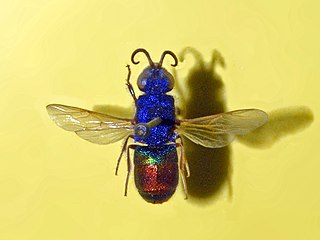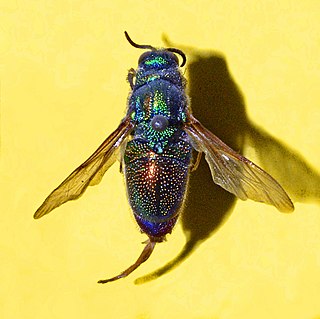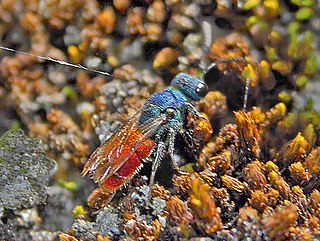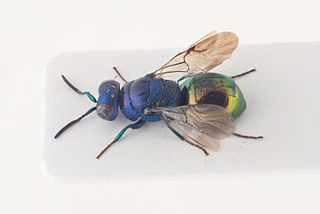
Commonly known as cuckoo wasps or emerald wasps, the hymenopteran family Chrysididae is a very large cosmopolitan group of parasitoid or kleptoparasitic wasps, often highly sculptured, with brilliant metallic colors created by structural coloration. They are most diverse in desert regions of the world, as they are typically associated with solitary bee and wasp species, which are also most diverse in such areas. Their brood parasitic lifestyle has led to the evolution of fascinating adaptations, including chemical mimicry of host odors by some species.

Chrysis inaequalis is a species of cuckoo wasps. The species occurs in Central and Southern Europe and in the Near East. The head and the thorax are shiny metallic blue-green, while the abdomen is red. Adults grow up to 5–10 millimetres (0.20–0.39 in) long and can be encountered from late June to mid September, especially flying on sun-exposed walls, on rocks and on dead wood.

Hedychrum rutilans is a species of cuckoo wasps. The species occurs primarily in Austria, Italy, Bulgaria, Greece, France, Poland, Portugal, Spain, Switzerland and in North Africa. The head and thorax are metallic green with red spots, while the abdomen is red. The color is more green and partially golden in the male and more extensively golden-red in the female. The body is somewhat hairy.

Chrysis is a very large genus of cuckoo wasps. It is the largest genus in the family, including over 1,000 species in over 20 subgenera, as speciose as all remaining Chrysididae combined. The generic name is derived from Greek chrysis, "gold vessel, gold-embroidered dress", and pays tribute to the brilliant metallic appearance of wasps in the genus.

Chrysis ignita is a species of cuckoo wasp. It is one of a group of species which are difficult to separate and which may be referred to as ruby-tailed wasps.

Chrysidea is a genus of cuckoo wasps.

Chrysidea pumila is a species of cuckoo wasps belonging to the subfamily Chrysidinae. Some authors consider this species as a synonym of Trichrysis pumilionis Linsenmaier, 1987.

Chrysis scutellaris is a species of cuckoo wasps.

Chrysis comparata is a species of cuckoo wasps.

Stilbum cyanurum, is a large Old World species of cuckoo wasps.
Chrysis elegans is a species of cuckoo wasps found in Southern Europe.

Chrysis viridula is a Western Palearctic species of cuckoo wasp, first described by Carl Linnaeus in 1761. Chrysis viridula is included in the genus Chrysis, and the family Chrysididae. It is a parasitoid of a number of species of eumenid wasp, mainly those in the genus Odynerus.
Chrysis provancheri is a species of cuckoo wasp in the family Chrysididae.

Chrysura simplex is a species of cuckoo wasps, insects in the family Chrysididae.

Chrysis ruddii, the ruby-tailed wasp, is a species of cuckoo wasps, an insects in the family Chrysididae.

Chrysis angustula is a species of cuckoo wasps, insects in the family Chrysididae.

Omalus aeneus is a species of cuckoo wasps belonging to the family Chrysididae.

Omalus biaccinctus is a species of cuckoo wasps belonging to the family Chrysididae.

Chrysis angolensis is a species of cuckoo wasp in the family Chrysididae, found throughout much of the world. It has been recently recorded as being introduced to French Polynesia. The species is a parasite of mud dauber nests, especially the black and yellow mud dauber Sceliphron caementarium.

Chrysis fulgida, the ruby-tailed wasp, is a species of cuckoo wasp in the family Chrysididae.


















